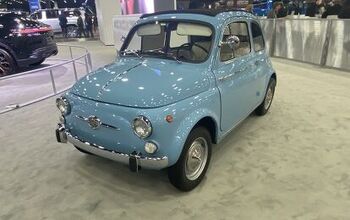Where Have All the Good Brands Gone?
In a video interview with Porfolio.com, Sir Nick Scheele explains how he turned Jaguar around. Well, not exactly; after all, he didn't. But the British brand’s former CEO did, as claimed, help raise Jaguar’s American JD Power quality rankings from second-to-last to first. In that regard, Sir Nick reveals that Jag’s ascension up the quality league tables hit the wall in ‘94. The breakthrough: after two years at the helm, Scheele realized Jag’s assembly line workers knew more about build quality than the suits. Scheele empowered the guys on the factory floor, left, ran Ford of Europe for a bit, collected a gigantic pension (and a peerage) and called it good. And now Sir Nick wants Jaguar back. Nooooooo.
I’m sure Ripplewood Holdings turned to Saint Sir Nicholas to assist them in their bid for Land Rover and Jaguar because the private equity group figured [correctly] that building cars is a fiendishly complex business. Best to hire someone who knows how to make a car roll off an assembly line– even if he didn’t do so at a profit (a failure for which the affable peer surely has a plausible explanation). In this they are only partially correct– the wrong part.
As Scheele’s Portfolio-assisted self-deification indicates, his lordship [still] has no idea what drives an automobile manufacturer to fame and fortune. To give credit where credit’s due, Scheele’s epiphany– his rejection of his class-bound cultural upbringing– brought him very, very close to the truth. Yes, every single employee working for a car company must be united in a common goal, and their input respected and (where appropriate) acted upon. But that goal is not quality. Or design. Or price. It’s the brand.
A tightly focused car brand is the plan, the vision, the way forward, the way out, the way back. It tells the company what kind of cars to make. It tells the marketing people how to sell them. It tells consumers why they should buy them. The brand defines the company, from the janitor to the CEO. Jaguar: pace and grace. What more do you need to know? This: without a strong brand, an automaker can’t pull together the hundreds of thousands of strands needed to form a coherent, inherently attractive car.
As what’s left of the American auto industry plays a multi-billion dollar game of musical chairs, not one of The Big 2.8’s CEOs has offered any indication to which tune they're moving. Less metaphorically, of branding, we’ve heard sweet FA.
“Boot’em Bob” Nardelli has not defined Chrysler, Dodge or Jeep automobiles. Alan “$25m will do nicely for my first year thanks” Mulally hasn’t told the world what a Ford, Mercury or Lincoln is or will be– other than badge engineered versions of transplant-a-like. Rabid Rick Wagoner has not stuck a flag in the ground for any of the company’s eight— count ‘em eight— brands.
Instead, all the Big 2.8’s CEOs have fixed the media’s attention on back office issues: cost cutting, incentives, fleet sales, asset sales, personnel changes, union negotiations, foreign expansion, international platform sharing, yada, yada, yada. While there’s no denying that decisions in these areas are critical to their companies’ hopes of turnaround/survival, Detroit’s CEOs are neglecting the one decision that informs all the others: what do their brands stand for?
If the Dodge brand stretches from a cheapo Caliber to a mega-SUV, how can Nardelli's mob decide what to put in/leave out of a Challenger ? Is it any wonder Cadillac's building a sub-CTS when the brand operates with two-thirds of a strap line ("Life, Liberty and the Pursuit")? Now that the Ford Taurus is "America's safest full size car" and Volvo's on the auction block, is safety the new Ford brand?
Of course, this lack of rigidly defined automotive branding is not just Detroit’s problem. Mercedes and BMW have stretched their brands beyond breaking point (the day of reckoning lies ahead). Even ToMoCo shows worrying signs of diminished brand coherence, as it builds cars that rely on something other than quality for sales (e.g. new xB). Even Porsche, the once tightly focused “fiercely independent” sports car company, seems Hell bent on destroying their brand equity. An SUV and four-door sedan? Great machines. Lousy branding.
There are still a few car brands keeping it real, such as Ferrari and Hyundai. Product excellence and a healthy bank balances indicate that the guys at the very top and the bottom of the market “get it.” As for Jaguar, there’s potential. Although Maserati's invading the pace and grace mindspace, at least the Germans and Japanese are staggering around elsewhere. But fans of the British brand (such as it is) can only hope Jaguar stays out of Scheele’s hands. Jag's savior– indeed the men at the helm of the The Big 2.8– must be ready, willing and able to be a slave to the brand. Nothing more, nothing less.
[See Scheele's spiel here.]
More by Robert Farago
Latest Car Reviews
Read moreLatest Product Reviews
Read moreRecent Comments
- Doc423 Rolling Coal is not a bad thing either.
- Ajla In high school I really wanted a yellow GTO.
- Lou_BC Sweet car.
- FreedMike With 157K miles, that's basically a beater that looks good. Plus, I heard Honda CVTs turn dicey with age. I'm a "no" at $12,500, but someone's heart will go all aflutter over the J-vin (Ohio-vin?) and pay up. With a manual in the same shape, I'd be in for a LOT less.
- EBFlex More proof the EV world is crumbling. In a market with supposedly “insatiable demand”, these kinds of things don’t happen. Nor do layoffs.


































Comments
Join the conversation
There is a reason that Toyota is able to be successful with both the Avalon and Lexus ES350. While both cars are priced about the same they appeal to very different tastes. A $35,000 Avalon appeals to those that just want a very good premium car without the extra brand baggage. There are some folks that do not wish to "flash" but still like to be comfortable. The Avalon makes the perfect Pastor's car, it is big, comfortable, can be loaded with a ton of features but it is still just a Toyota. The Avalon also has the appeal of being the "fiscally responsible car" (all the luxury without the designer label). Anyone who is familiar with Toyota's XLE or Limited models will know that these cars are generally equiped to the level of many so called premium upmarket brands. The Lexus ES350 is a smaller car but has the extra cache value that many want and expect in a $35,000 car. Call it a jazzed up Camry if you will but it does the job of being a premium luxury car quite well, and manages to look and feel more upmarket than the Avalon. If I use my 60 year old parents as an example I can better explain this; The Avalon appeals to my father, the practical conservative man. He understand that the Avalon and the ES350 are basically the same car and will prefer to get more car for his money, he is not brand/badge consious. My mother will go for the ES350 because it is the Lexus and has much more style and flash than the Avalon, it also looks better at the country club. My point, Toyota has covered all bases and stands a very good chance of making that $35,000 sale in that household. Whoever wins the arguement between my parents as to which car to buy Toyota will still make the sale and the money! Branding and good products go hand in hand. If your products suck the consumer could careless about any other "brands" from that company. Companies that make inferior junk, do just that make inferior junk and a new brand will do little to help. On the otherhand a company with a stellar reputation for quality with be able to mint money with new brands because the consumer is actually looking for "new", "bigger", "better", and "more" from them.
@MX5bob: We Americans have very narrow brand perceptions. Is that more of an American trend, or is it universal across Europe and Asia? Somebody here's got to have studied this sort of thing. Anyway, I know people that swoon over the Mercedes badge, even though many drive base C classes that cost about as much as a fully equipped Accord.